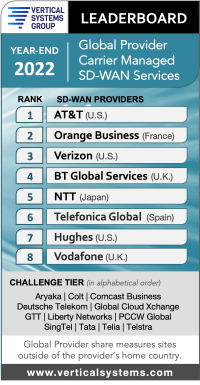Vertical Systems Group released its year-end 2022 Global Provider Carrier Managed SD-WAN Leaderboard, ranking AT&T, Orange Business and Verizon as the top three, respectively, in the healthy market.
BT Global Services, NTT, Telefonica Global Solutions, Hughes and Vodafone completed the list of top companies for managed SD-WAN services, all of which have been expanding their footprints into new countries to offer connectivity to multinational customers, according to Vertical Systems Group.
The group noted that only the top three – AT&T, Orange Business and Verizon – have attained a MEF 3.0 SD-WAN certification.
The leaderboard defined managed SD-WAN as requiring a software-defined network (SDN) service architecture that provides dynamic optimization of traffic flows, a “purpose-built” SD-WAN appliance or customer premises equipment-hosted SD-WAN functionality at each customer edge site.

Vertical Systems Group said a managed SD-WAN should also support multiple active underlay connectivity services, automated failover fast enough to maintain active sessions and centralized network orchestration with traffic and application visibility end-to-end.
A recent Futuriom report noted that network-as-a-service (NaaS) has garnered attention across verticals – and managed SD-WAN is “part of that trend.” NaaS is a network consumption model that is “as a service,” rather than customers building out their own networks.
“The end user simply uses the service. This business model has been the great driver of enterprise software through the SaaS model – and it’s now becoming part of the infrastructure model,” explained Futuriom Analyst Scott Raynovich in the report. “From the CxO’s perspective, NaaS is great because it falls as an operating expense rather than a capital expense. It’s also more flexible, because services can be added on demand without requiring a heavy up-front investment.”
For SD-WAN managed services, large service providers like AT&T typically team up with an SD-WAN vendor for the underlying SDN technology and platform. Raynovich said building an enterprise-class SD-WAN managed service requires cooperative effort from service providers and vendors and requires companies that have “significant scale and expertise.”
There is usually complex integration work involved. For example, the provider and vendor may need to connect to separate billing and support Systems (BSSs) or operations support systems (OSSs) from vendors such as Amdocs, Ericsson, Netcracker and Nokia (the BSS and OSS leaders, according to Futuriom).
Additionally, integrating a managed service with transport and underlay can prove difficult. However, the Futuriom survey showed that’s what many end users are looking for in a managed SD-WAN solution.
“There are dozens of SD-WAN and SASE providers, but only a few have the scale and platforms designed specifically for use by the major service providers to roll out managed services,” Raynovich said.
Vertical Systems Group pointed to some of the notable SD-WAN vendors that service providers are partnering with for their managed services, including Cisco, Fortinet, HPE Aruba, Nokia’s Nuage Networks, Palo Alto Networks, Versa Networks and VMware.
Managed SASE surges
Vertical Systems Group said when considering managed SD-WAN offerings on the market security is the “most essential” capability that may be added, indicating the importance of new network security trends like secure access service edge (SASE).
Coined by Gartner, SASE is a converged framework for cloud-based networking (SD-WAN) and security -- including secure web gateway (SWG), cloud access security broker (CASB), firewall-as-a-service (FWaaS) and zero-trust network access (ZTNA).
The COVID pandemic accelerated the SASE market, due to a lasting transition to hybrid work and a shift in network focus from traditional enterprise sites to remote and hybrid environments, Raynovich noted. The "core value" of SASE is to deliver secure access to applications and data from anywhere.
"With more people using the internet to access the cloud, SD-WAN was needed to provide better intelligence and security for access to both enterprise and cloud software-as-a-service (SaaS) apps," he said. "For example, the network needed to know which services users needed in order to access better control and provide security for apps, especially those accessed outside of the enterprise on the internet."
Many providers who have traditionally offered managed SD-WAN services are venturing into the converged networking and security market, adding those cloud-based security functions to their portfolios.
In Futuriom’s survey, 98% of respondents said that hybrid work has increased demand for SASE and ZTNA, with 92% considering ZTNA a crucial component.
“What’s needed more than ever are software-based platforms for integrating the management of network and security functions at the same time,” Raynovich said. “This approach was first initiated by SD-WAN, which separated the software control from the hardware for branch-office networking. SD-WAN evolved and grew by adapting security functionality (SASE), which could be integrated into the network platform.”